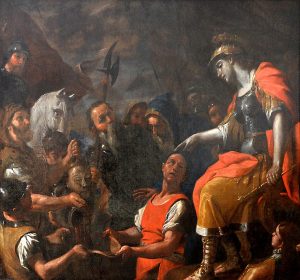Cyrus the Great was the founder of the Achaemenid empire and was widely known for conquering the Median, Lydian, and Neo-Babylonian empires. The Jewish Bible dubs him as the liberator of the Jews from Babylonian captivity, as he ruled over Babylonian territory from 559 to 530 BC.
Three Varied Accounts
Ancient sources on the events of Cyrus the Great’s death contradict one another. The “Father of History” Herodotus who wrote the ancient text Histories, stated that the Persian king died in a battle against the Massagetae. The nomadic tribe that came from Eastern Iran had forces that would resemble both cavalry and infantry forces. Cyrus had proposed marriage to their empress, Tomyris, but she refused to wed him. He proceeded to attack the Iranian tribes by destroying their bridges and war boats. The empress asked them for a formal battle far into her territory, a request he followed, bringing his most capable soldiers to fight with him and leaving his weakest behind with wine and food. Her army defeated the warriors that were left and consumed the wine which made them drunk.
An ambush on Tomyris’ general and son, Spargapises, resulted in the loss of many of the Massagetae soldiers, prompting their leader to kill himself. After which, Tomyris led her army into battle, killing Cyrus the Great in the ensuing fight. Herodotus described the empress severing the king’s head and dipping it in blood; however, he also stated that his source for these details had multiple versions of the events and that no one witnessed the aftermath of the battle.
In a different account, Athenian-born historian and commander Xenophon told the story in his fictional biography of Cyrus entitled Cyropaedia, describing the king’s illness which lasted three days. Cyrus then called for his two sons to divide the empire between them and spent his last moments in Greek meditation.
Lastly, the Greek historian and physician Ctesias expressed in the lost Greek writings of Persika two ways in which Cryus died: one in bed and one while he was in battle. All three accounts of Cyrus’ death are different, possibly to provide propaganda in their favor, but Herodotus is more widely referenced.
Artifacts with cuneiform inscriptions reveal that Cyrus died sometime in December of 530 BC. His son Cambyses succeeded him to continue expanding the empire. He died after only 7 years on the throne.
Burial
The Greek historian Aristobulus provided a lost ancient text that was referenced by the philosopher and historian Arrian, detailing the tomb of Cyrus the Great. Reportedly, his body was buried in the capital, Pasargadae. Aristobulus was tasked by Alexander the Great to inspect the tomb twice. Arrian and another Greek historian, Strabo, have similar depictions of the physical appearance of the tomb in which Aristobulus saw a golden coffin beside a couch holding jewels and drinking vessels. On the second time he visited, the tomb was looted and stripped of its treasures. Today, the tomb of Cyrus the Great is open to viewing in the Fars Province in Iran.
